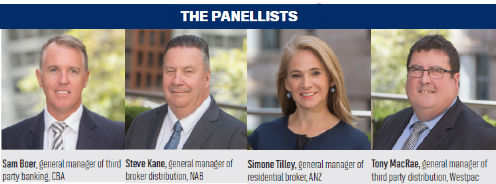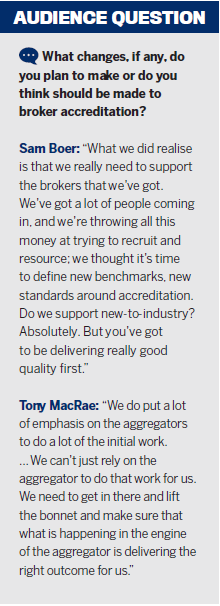The four majors on commissions, accreditation, turnaround times and IO borrowers

The four broker heads of Australia’s biggest banks were put in the spotlight in February during MPA’s live-streamed roundtable event. Here’s where they stand on commissions, accreditation, interest-only borrowers and much more
The current political and social climate has not been particularly favourable towards the major banks of late – and of course everyone has a different opinion about whether or not the banking royal commission’s laser inspection is warranted, brokers included.
So, with that tense environment as the backdrop, we invited the four broker heads of Australia’s biggest banks to sit in the hot seat for a Q&A session broadcast live on MPA’s website.
While a bit of cajoling was required, all four major banks did finally come to the table on 16 February for the first time since MPA’s debut roundtable in 2014. (In 2017, CBA did not participate.)
Thanks are due to Simone Tilley, general manager of residential broker, ANZ; Tony MacRae, general manager of third party distribution, Westpac; Steve Kane, general manager of broker distribution, NAB; and Sam Boer, general manager of third party banking, CBA, for contributing to a lively discussion with MPA’s new editor, Otiena Ellwand.

With all four banks in the ring, hundreds of brokers – a record number in fact – registered to watch the roundtable, and many of you also submitted questions for the panel.
It’s clear that as the broking and banking industry continue to go through significant transitions this year, brokers will be thirsty for information from the major banks.
During this roundtable, we found out more about where each bank stands on commission changes and interest-only borrowers; comprehensive credit reporting and turnaround times. One major bank head – you can probably guess who – even admitted that he knew he hadn’t been popular among brokers of late. He took the opportunity to explain himself.
We also found out more about where the majors are going with the third party channel and how they plan to support brokers this year.
We reserved some time at the end to ask the panel a couple of the questions brokers had submitted around accreditation and channel conflict. Unfortunately we ran out of time before we could ask more. But that doesn’t mean this conversation is over. We’re always keen to hear from you so we can put the questions that matter to you to these industry leaders when we get them in the hot seat again.
You can find out what these four bankers had to say on the following pages, and the entire roundtable discussion is also available for viewing on the MPA website.
Our next roundtable will be with the non-major banks. You can submit your questions now by emailing otiena.ellwand@ keymedia.com. We also look forward to continuing this discussion on our website at mpamagazine.com.au.
Q: What could be the long-term outcomes of the Combined Industry Forum’s recommendations?
Addressing the proposals of the Combined Industry Forum around commission and governance and discussing the possible outcomes of these decisions was at the top of the agenda at this year’s roundtable.
The CIF published its report in December. Its aim was to deal with the concerns expressed by ASIC in its Review of Mortgage Broker Remuneration, while also preventing any further regulatory intervention.
The main reform proposed for commission is to base remuneration on funds drawn down and utilised by the customer net of offset to “avoid financial incentives that encourage consumers to borrow more than they need or will use”. Funds drawn down will generally be measured and commission paid on initial settlement, and at a later point in time for subsequent drawn-down amounts, up to the maximum facility limit, the CIF said.
As for governance, there will be a lot more data sharing about brokers’ performance. Brokers will be issued with a unique identifier number and lenders will report back to aggregators on ‘key risk indicators’ of individual brokers, insights that could drive remedial training and professional development. Brokers and aggregators will also have to share information on the lenders they use.
“I think there’s an opportunity for us to think about how do we have a review process each year to justify trail and be very open and transparent to customers as to what is being paid” - Tony MacRae, Westpac
The four panellists praised the CIF for bringing diverse groups together, including lenders, aggregators, consumer groups and brokers, to determine how the industry could be improved to meet better consumer outcomes and encourage growth.
Simone Tilley, of ANZ, called what the CIF had achieved over six months as “genuinely remarkable”, even more so because of the changed expectations of government and consumers and the much more complex environment in which the industry now exists.
“What I saw was everyone park their own motivations and genuinely talk openly about what was right, and I think it was really a testament to and illustrative of everybody’s integrity and leadership around the table,” Tilley said.
Going forward, everyone will be operating with the same ethos around what is right and what is most suitable, she said.
“Irrespective of what customer a broker engages across Australia, irrespective of which broker, or which lender is integrated … we are all operating with the same mindset and focus around customer. We’ve started, but there is a lot of work to do.”

Tilley and Sam Boer, of CBA, pointed out that the challenge was now how to execute the CIF’s proposals in efficient and effective ways. Tilley said the success of the six key reform items relied on “the whole being greater than the sum of its parts”.
“We can’t underestimate the complexity of execution,” she said.
Boer said: “We don’t want to create more overheads and administration than is necessary. There is going to be a lot of change, and it’s going to test the industry, I do believe. And I think our role is going to be to really support that, and that’s the position we’ve taken.”
Tony MacRae, of Westpac, agreed that there was still a lot of work to do.
“There are some areas where we haven’t gone far enough yet, and there will be expectation from other groups that we may need to go further,” he said.
Now that a ‘good customer outcome’ has been defined by the CIF, MacRae said the industry needed to ensure that it had “appropriate sanctions in place” for when a poor consumer outcome occurred, such as when a customer was put into a loan they couldn’t afford and it went into arrears in the early months.

While the CIF did not make any changes to clawbacks, it did leave that open for further review. Its sixth proposal suggests introducing an improved governance framework under which the industry would continuously self-assess such things as remuneration structures, including upfront, trail and clawbacks, to the extent that they negatively impacted customer outcomes.
“I think there’s an opportunity for us to think about how do we have a review process each year to justify trail and be very open and transparent to customers as to what is being paid,” MacRae said.
With consumers and the regulators demanding more transparency, the industry had to be open about its transactions to make it clear to industry participants “that we’re adding real value, as the bulk of brokers do today”, he said.
Q: Are we likely to see further changes to the calculation of household expenses?
APRA has made it clear that living expenses and lending to borrowers with a low net income surplus will be a key area of focus for the regulator in the years to come.
Last November, APRA chairman Wayne Byres questioned whether the Household Expenditure Measure provided a realistic enough assessment of a borrower’s genuine expenditure.
“From APRA’s perspective, we would like to see the industry devote more effort to the collection of realistic living expense estimates from borrowers and give greater thought to the appropriate use and construct of benchmarks in instances where those estimates are deemed insufficient,” he said at the time.
Steve Kane, of NAB, said that while the use of benchmarks was important, the use of actual data to see where a customer sat within these benchmarks would lead to much more accurate assessments. The introduction of comprehensive credit reporting would help brokers and lenders better determine a customer’s ability to service the debt, he said.
“We’re in a benign interest rate environment at the moment, but it won’t always be that way,” Kane said. “Making sure that customers are in the right product that they can service is a vitally important part of what a broker does, and it’s incumbent upon all of us in the industry to make available data to improve the methodologies of that."
“Irrespective of what customer a broker engages across Australia, irrespective of which broker, or which lender is integrated … we are all operating with the same mindset and focus around customer” - Simone Tilley, ANZ
When asked if banks and brokers were collecting the right information about borrowers, MacRae said he thought that they were getting better at asking borrowers more granular questions, but it was also about balancing and achieving efficiency in the information-gathering process.
He acknowledged how difficult it was for some customers to provide the correct information, not because they were deliberately trying to be deceptive or to mislead anyone, but often because they didn’t know the answer, or in some cases didn’t want to know. MacRae agreed with Kane that better use of and access to data would achieve better results for the customer.
On the day of the roundtable, Westpac and ANZ introduced changes to their assessment and approval of borrowers. Westpac said the bank had introduced strict tests of residential property borrowers’ current and future capacity to repay their loans.
The banks will likely continue to tighten their serviceability measures as APRA zeroes in on borrowers’ ability to repay loans.
Q: Will we see any discounts for interest-only borrowers this year?
Interest-only loans attracted a lot of scrutiny in 2017, with APRA capping the amount of new interest-only loans at 30% last March. Then, in October, ASIC released its review into interest-only lending, revealing that borrowers who used brokers were more likely to obtain an interest-only loan compared to those who went directly to a lender.
By the end of the September 2017 quarter, the proportion of interest-only loans written by the banks had fallen to just 16.9%, according to APRA’s property exposure data.
CANSTAR group executive Steve Mickenbecker had a foreboding forecast. “My suspicion is APRA and the banks will have seen that interest-only for noninvestors … is almost dead,” he told MPA in December.
Our panellists didn’t say there was no future for interest-only loans, just that things had and would continue to change when it came to this type of loan.
“Interest-only remains a valid strategy for many investors in the marketplace, and we will continue to provide and support those where it makes sense and it’s a valid investment strategy for them, and we’ll price it appropriately,” MacRae said.
The major bank heads emphasised the importance of gaining a deep understanding of the needs and objectives of the customer in order to determine the best product for them.

Boer said that as he’d been travelling around the country talking to brokers he’d been asking them when they thought it was appropriate to sell an interest-only loan to an owner-occupier.
“It’s very interesting to see the mixed response here. I think this is one of those grey areas where we need to do more work and be very clear around what is the appropriate situation,” he said.
Another factor at play is some customers’ lack of knowledge around interest-only loans. The UBS Evidence Lab’s 2017 Australian Mortgages Survey of 907 respondents found that about a third of interest-only borrowers were unaware of the type of mortgage they had. “Interest only borrowers via the broker channel are more likely to be under high financial stress from recent rate rises,” the UBS analysts wrote.
“[CCR is] a positive thing for the overall economy. It’s a positive thing for customers and for brokers. It’s an extra tool for them to be able to really verify the position of a customer when assessing serviceability” - Steve Kane, NAB
Kane said that for brokers it really came down to making sure an interest-only loan fit and made sense for the borrower’s circumstances – as well as ensuring that the customer knew and understood what it would mean for them both in terms of their immediate needs and in the future.
“Did the customer really understand that in paying interest only they weren’t reducing the principal on their debt? Is it suitable for them in the long run?” Kane said. “Is the broker looking at the longer term and does the customer understand the product that they’re getting into and the outcome as it concerns the debt that they have?”
Q: How will the introduction of comprehensive credit reporting affect brokers?
Comprehensive credit reporting will become mandatory in July, starting with the big four banks. They’ll be required to make 50% of their credit data ready by July, with this increasing to 100% a year later, and they could face steep penalties if they don’t comply.
Treasurer Scott Morrison has predicted that CCR will encourage competition, improve lenders’ ability to meet responsible lending obligations, and even allow customers with good credit histories to obtain lower interest rates on loan products.
But not everyone thinks it’s a good idea.
FBAA executive director Peter White has been vocal about his displeasure with CCR. He suspects the banks will maintain their current interest rate margins for customers with a better credit file, and increase the rates for those who are seen as “lesser quality or higher risk”. “This normally impacts those who can least afford to pay higher interest rates, so it exacerbates their problems and helps no one,” he said.
None of the major bank heads expressed as strong opinions on CCR as White, but Boer did admit that he was “sitting on the fence”.
“This is one of those areas where I really want to see it. I really want to see how it plays out.”
It has been suggested that CCR will increase efficiency around the credit process, but Boer said he would wait and see before passing judgment.
As for how it will affect brokers, he doesn’t think it will shift the focus away from the things that the panel discussed around the need to be very transparent with customers, particularly regarding expenses, loan affordability, suitability and best interests.
Kane had a more affirmative take on CCR, saying it would change the dynamics and become “vital from a broker’s perspective”, especially in regard to the validation and serviceability process.
He said it was up to the banks to participate wholly and fully to ensure that the data going in was being reported accurately.

“I think it’s a positive thing for the overall economy. It’s a positive thing for customers and for brokers. It’s an extra tool for them to be able to really verify the position of a customer when assessing serviceability," Kane said.
When asked if the impact of CCR had been exaggerated, Tilley said it was first important for people to thoroughly understand what it was going to deliver. She explained that it would enable a lender to gain a broader understanding of someone’s credit history and to identify the patterns and their adherence to repayment terms over time, revealing positive and negative information. That should have positive effects for those who may have a limited financial history, or who have defaulted in the past but are generally pretty diligent.
“[Turnaround times are] very big and very complicated and very expensive; it’s like the Holy Grail. We’ve been doing this for how long and we still haven’t got it right? … With the rate of change [in] our industry, you’re forever chasing this one” - Sam Boer, CBA
Tilley believes CCR will unlock a rich source of information that will allow lenders to make a “more fair and balanced decision that will support the Australian marketplace”.
MacRae said Westpac was supportive of CCR, but he also shares Boer’s healthy skepticism and desire to see the system in action first.
“To me it’s a simple sort of fundamental: the more information you can gather and the more efficient way you can gather that information has to lead to more informed decisions,” he said.
But he pointed out that there would still be a small gap in the information available come July, because only the majors were required to show their hands at that point. He also said it was crucial that, as this information was made available, people’s information and privacy should be respected and privacy should be respected and protected.
Q: What actions have you takaen to cut and improve consitency in turnaround times?
Turnaround times and BDM support are consistently voted by brokers as the most important areas of service. But last year’s MPA Brokers on Banks survey showed some dismal results. In 2017, 40% of brokers said turnaround times had worsened, compared to 16% in 2016.
We turned to MacRae first. Westpac had a good year last year, according to the survey, coming in first for turnaround times, BDM support and online platform and services.
“This is a constant focus, and as volumes fluctuate up and down, it becomes increasingly difficult,” MacRae said.
“What we’re looking at doing is cutting out hand-offs, unnecessary steps in the process and requesting of unnecessary information.”
But MacRae said that, at the end of the day, it was not just the bank’s problem. What gets submitted to the bank has as big an impact on turnaround times as the actual operation in the back office, he said.
He added that it was important not to forget there was a customer at the end of that file. Purchasing a home was hugely stressful, he said, with the high points being finding the home and then getting the keys.
“We have all the tough stuff in the middle that we have to help customers navigate through,” MacRae said.
Tilley said ANZ was building the leadership capability of its team to drive process improvement. She explained that the bank had invested in its home loans platform and would continue to make improvements to it this year. ANZ has also been working on addressing and identifying bottlenecks that occur in the process to determine if and where there are knowledge gaps so it can find ways to better support and educate brokers.
"[By] just being a little bit more curious... about our value chain in its entirety, we're able to work more efficiently with one another," Tilley said.
Kane agreed that it was important to understand where the gaps were in the process, and if a step didn't add value it was important to scrutinise why it was there. He said that at NAB there was a strong focus on staff's skills development to ensure the internal team was up to date with the tasks assigned.
Boer said he understood how difficult it could be for brokers, with each bank having a different system and process for filing applications.
Ensuring that there were quality inputs and outputs relied on both sides having the necessary education and training, as well as the right systems and processes in place, he said.
"It's very big and very complicated and very expensive; it's like the Holy Grail. We've been doing this for how long and we still haven't got it right? And it's going to continue, and with the rate of change that keeps coming into our industry, you're forever chasing this one. It's something we all aspire to."



